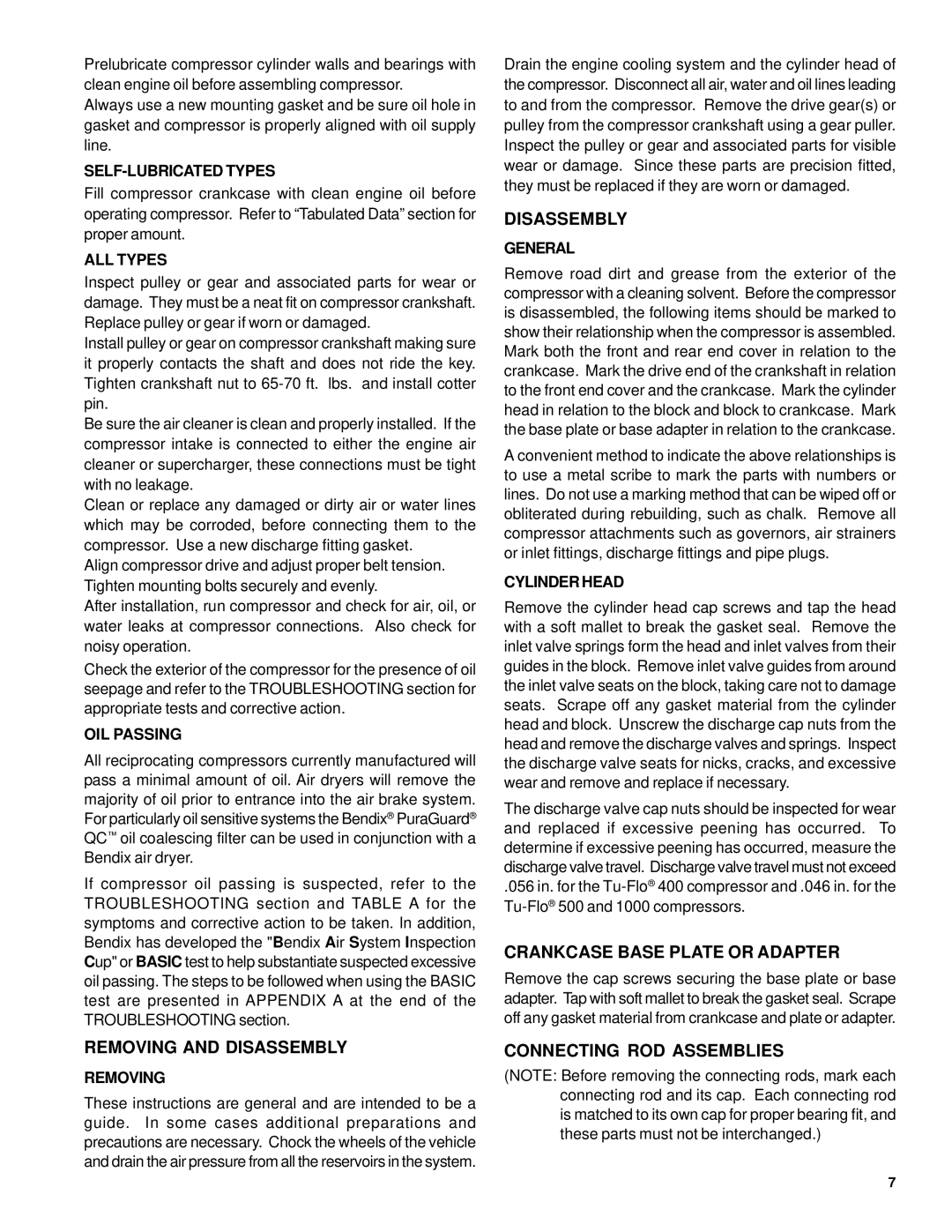Prelubricate compressor cylinder walls and bearings with clean engine oil before assembling compressor.
Always use a new mounting gasket and be sure oil hole in gasket and compressor is properly aligned with oil supply line.
SELF-LUBRICATED TYPES
Fill compressor crankcase with clean engine oil before operating compressor. Refer to “Tabulated Data” section for proper amount.
ALL TYPES
Inspect pulley or gear and associated parts for wear or damage. They must be a neat fit on compressor crankshaft. Replace pulley or gear if worn or damaged.
Install pulley or gear on compressor crankshaft making sure it properly contacts the shaft and does not ride the key. Tighten crankshaft nut to
Be sure the air cleaner is clean and properly installed. If the compressor intake is connected to either the engine air cleaner or supercharger, these connections must be tight with no leakage.
Clean or replace any damaged or dirty air or water lines which may be corroded, before connecting them to the compressor. Use a new discharge fitting gasket.
Align compressor drive and adjust proper belt tension. Tighten mounting bolts securely and evenly.
After installation, run compressor and check for air, oil, or water leaks at compressor connections. Also check for noisy operation.
Check the exterior of the compressor for the presence of oil seepage and refer to the TROUBLESHOOTING section for appropriate tests and corrective action.
OIL PASSING
All reciprocating compressors currently manufactured will pass a minimal amount of oil. Air dryers will remove the majority of oil prior to entrance into the air brake system. For particularly oil sensitive systems the Bendix® PuraGuard® QC™ oil coalescing filter can be used in conjunction with a Bendix air dryer.
If compressor oil passing is suspected, refer to the TROUBLESHOOTING section and TABLE A for the symptoms and corrective action to be taken. In addition, Bendix has developed the "Bendix Air System Inspection Cup" or BASIC test to help substantiate suspected excessive oil passing. The steps to be followed when using the BASIC test are presented in APPENDIX A at the end of the TROUBLESHOOTING section.
Drain the engine cooling system and the cylinder head of the compressor. Disconnect all air, water and oil lines leading to and from the compressor. Remove the drive gear(s) or pulley from the compressor crankshaft using a gear puller. Inspect the pulley or gear and associated parts for visible wear or damage. Since these parts are precision fitted, they must be replaced if they are worn or damaged.
DISASSEMBLY
GENERAL
Remove road dirt and grease from the exterior of the compressor with a cleaning solvent. Before the compressor is disassembled, the following items should be marked to show their relationship when the compressor is assembled. Mark both the front and rear end cover in relation to the crankcase. Mark the drive end of the crankshaft in relation to the front end cover and the crankcase. Mark the cylinder head in relation to the block and block to crankcase. Mark the base plate or base adapter in relation to the crankcase.
A convenient method to indicate the above relationships is to use a metal scribe to mark the parts with numbers or lines. Do not use a marking method that can be wiped off or obliterated during rebuilding, such as chalk. Remove all compressor attachments such as governors, air strainers or inlet fittings, discharge fittings and pipe plugs.
CYLINDER HEAD
Remove the cylinder head cap screws and tap the head with a soft mallet to break the gasket seal. Remove the inlet valve springs form the head and inlet valves from their guides in the block. Remove inlet valve guides from around the inlet valve seats on the block, taking care not to damage seats. Scrape off any gasket material from the cylinder head and block. Unscrew the discharge cap nuts from the head and remove the discharge valves and springs. Inspect the discharge valve seats for nicks, cracks, and excessive wear and remove and replace if necessary.
The discharge valve cap nuts should be inspected for wear and replaced if excessive peening has occurred. To determine if excessive peening has occurred, measure the discharge valve travel. Discharge valve travel must not exceed
.056 in. for the
CRANKCASE BASE PLATE OR ADAPTER
Remove the cap screws securing the base plate or base adapter. Tap with soft mallet to break the gasket seal. Scrape off any gasket material from crankcase and plate or adapter.
REMOVING AND DISASSEMBLY
REMOVING
These instructions are general and are intended to be a guide. In some cases additional preparations and precautions are necessary. Chock the wheels of the vehicle and drain the air pressure from all the reservoirs in the system.
CONNECTING ROD ASSEMBLIES
(NOTE: Before removing the connecting rods, mark each connecting rod and its cap. Each connecting rod is matched to its own cap for proper bearing fit, and these parts must not be interchanged.)
7
